In this blog post, Marie discusses her thoughts on how the pros & cons and other SERP annotations can give users clues on creating great content!
Marie discusses pros and cons SERP annotations on Youtube
Have you seen these pros and cons annotations in Google’s search results?


(examples shared on Twitter by SpamTaylor)
Some have speculated that these are generated by use of structured data but this is likely not the case.
Simone De Palma pointed out that this Google patent called “Search result annotations” can explain what we are seeing.
🤖Google New Pros & Cons are not #RichResults but #Annotations.
The search engine can extract the most positive and negative n-grams from a page.
Yet this is not the only one as it all boils down to a 2021 patent.
More in this thread🧵— Simone De Palma (@SimoneDePalma2) July 1, 2022
When I saw these and realized that Google was likely extracting information from pages to create these, I got pretty excited. The patent we will discuss in this article shows how Google can extract information from our pages, from other pages, from knowledge graphs and several other sources and determine how to display this to searchers in a way that satisfies their intent. At the end of this article I’ll share some tips on how we can practically use this information to create really good content in regards to products and product reviews.
What does the search result annotations patent say?
This patent was published in December of 2021.
Any time we discuss Google patents we need to add the common disclaimer that we do not know whether the techniques described in the patent are actually being used in Search. It really does seem to me though that these annotations are currently in use by Google.
Here is the abstract:
A flexible annotation framework normalizes auxiliary information from diverse sources, ranks the information for an individual search result, and provides a lightweight or full display of the auxiliary information in an annotation for the search result. An annotation thus displays information not typically part of the details included in the search result. An example method comprises, for at least one item in a search result page, identifying at least one annotation of a first annotation type in an annotation data store that references the item, identifying at least one annotation for a second annotation type in an annotation data store that references the item, ranking the annotation of the first annotation type and the annotation of the second annotation type and providing the highest ranked annotation as part of a search result for the item in the search result page.
In other words, the patent describes a framework that can take information about products from a bunch of sources. This is information that would not normally be included in the search results and also does a good job of showing the searcher that their answer is to be found on this page. While the examples that prompted me writing this article were for seeing “pros and cons” right in the SERPs there are several other examples given in the patent as well.
By looking at the examples given, we can possibly get clues to help us create content that gets more clicks and actually ranks better because it does a better job of satisfying user intent.
The patent tells us that one benefit of having these annotations in the SERPS is that it will result in less clicking around for searchers because they make it more likely that the searcher’s intent will be met:
“The annotation provides justification for the rank of the search result and may result in fewer follow-on queries because the user has a level of confidence that the result matches the intent.”
How are these annotations generated?
When we do a search, Google provides us with a list of documents in their index that are likely to match our query. We see the page title and a description (snippet) to help us determine which result to click on. These annotations…pros and cons, mentioned in, notes from reviewers, etc. add more detail right in the search results:
“Annotations represent auxiliary data about the search result, which is not part of the fundamental item details that are typically included in a search result.”
In this example, Alan Martin shows a SERP where a search for “larceny bourbon” generates a results that says, “Pros and cons: Smooth and tasty bourbon – Great flavor profile – Reasonable price point” from this page on gentlemenranters.com.

These words are found on the page, but not in one single place. They are not specifically listed as pros and cons.

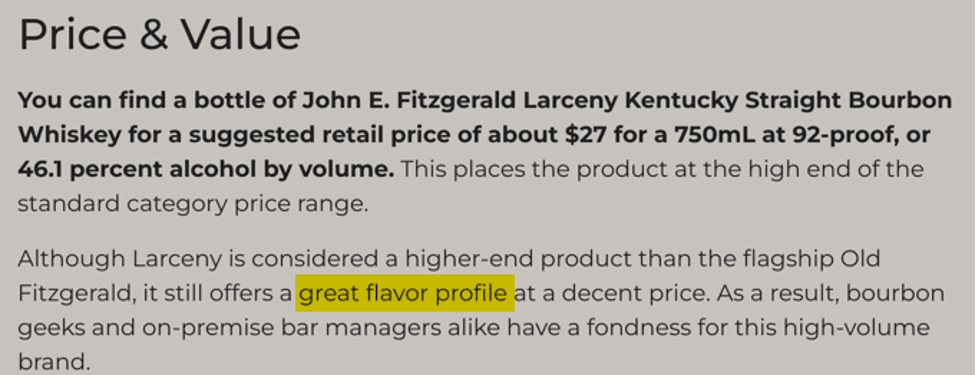
Google’s rich results testing tool does not show structured data as a possible cause for these annotations as the page only uses articles and breadcrumb structured data.
This means that Google is able to extract unstructured data (i.e. data that is not marked up with schema), determine what information is helpful to the user and piece it all together!
Note: On Aug 5, 2022 Google announced new structured data we can use for pros and cons:
New in structured data: you can now tell Google about the pros and cons of a product with markup. Learn more: https://t.co/9wcULoBGGQ
— Google Search Central (@googlesearchc) August 5, 2022
Their article says,
You can tell Google about your pros and cons by supplying pros and cons structured data on editorial review pages. When you’re adding structured data to your web pages, you can use Rich Results Test to make sure it’s correct and valid for Google Search. The tool has been recently extended to check for pros and cons structured data in addition to all the other structured data types supported by Google Search.
If you do not provide structured data, Google may try to automatically identify pros and cons listed on the web page. Google will prioritize supplied structured data provided by you over automatically extracted data. We tested this with website owners, and received positive feedback on this capability.
The article goes on to give a JSON-LD example you can use to implement structured data. As of Aug 5, 2022, it is only applicable to product review sites, not merchants.
Back to unstructured data. Let’s look at this patent.
The patent describes creating an index that associates terms, phrases and n-grams (a series of words) with items. These items may be:
- products
- books
- applications
- services
- hotels
- restaurants
- flights
- entities
The terms, phrases or n-grams that can be associated with these items may taken from:
- a description of an item
- reviews about an item
- a document (web page, pdf, etc.)
- a knowledge base or knowledge graph
From the patent: “Some annotations can also provide tangential data, e.g., from a secondary source or the primary source, that may enable a user to more efficiently evaluate items in the search result page. “ and “A machine-learned scoring algorithm may rank all obtained annotations for an item and provides one or more annotations to display as part of the search result for the item.”
The patent gives several possible reasons for including annotation in the SERPS:
- “Some annotations can provide justification for or insight into the ranking of the responsive search items.”
- “Some annotations can also provide tangential data, e.g., from a secondary source or the primary source, that may enable a user to more efficiently evaluate items in the search result page.”
- “The use of annotations as disclosed herein results in more informed clicks, saving computing resources and user time. The use of annotations as disclosed herein may also result in fewer follow-on queries.”
- “Implementations also conserve computing resources by increasing the confidence of a user in the search results presented, making it less likely that the user will submit multiple queries to arrive at a sought for answer.”
Specific examples showing where annotation information can be pulled from!
Query: “Headphones”
In this case, the annotations displayed in the SERPS include “mentioned on…” and notes from people who have reviewed the product.
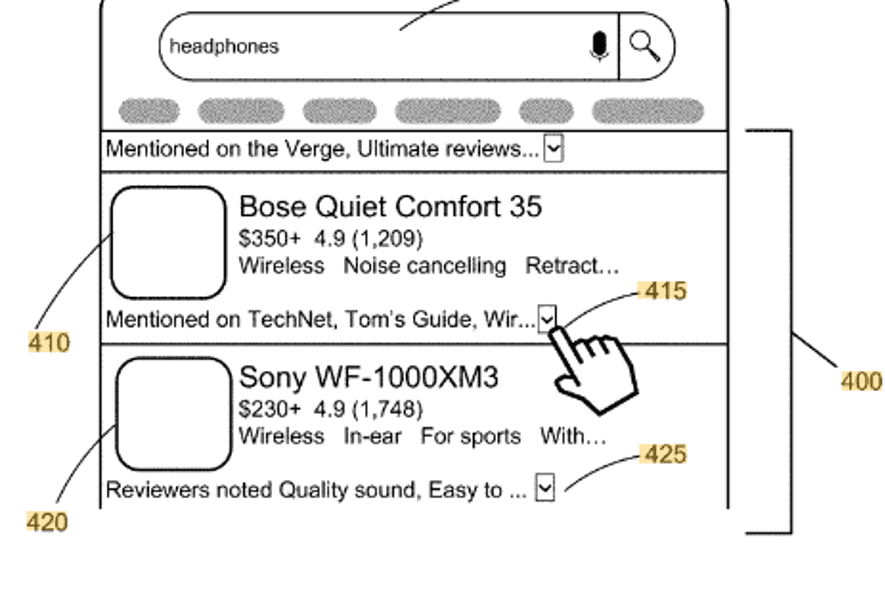
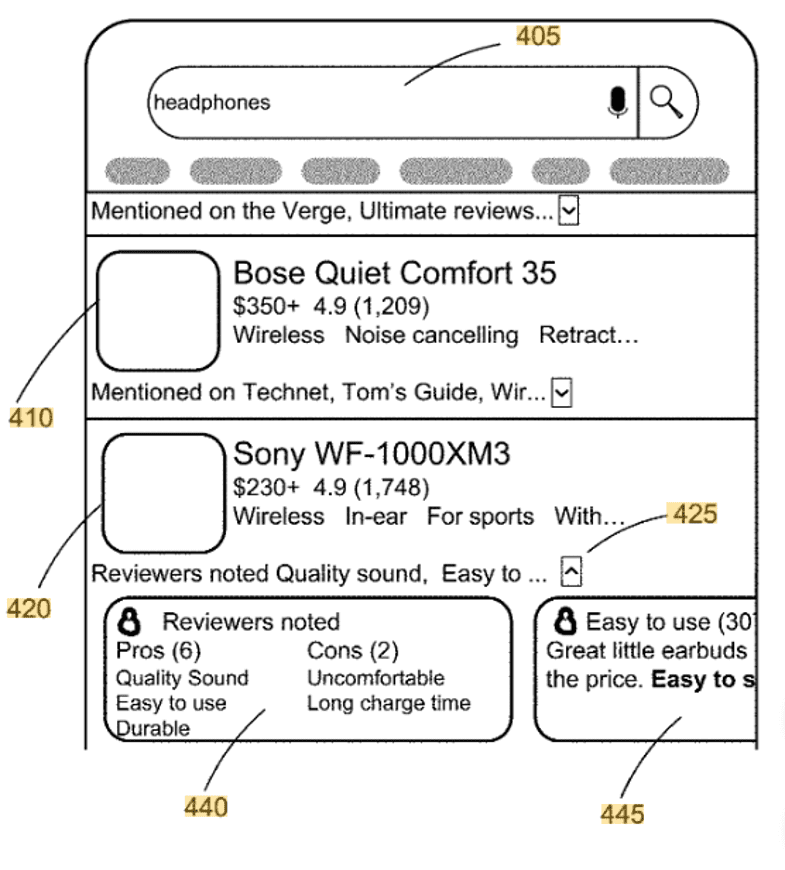
What can we learn from this? Getting your product mentioned in authoritative places could possibly help you earn these annotations and improve user trust. Sounds like E-A-T, right? Also, encouraging users to leave descriptive reviews of your product, including their thoughts on pros and cons could prove valuable.
Query: “Headphones for running”
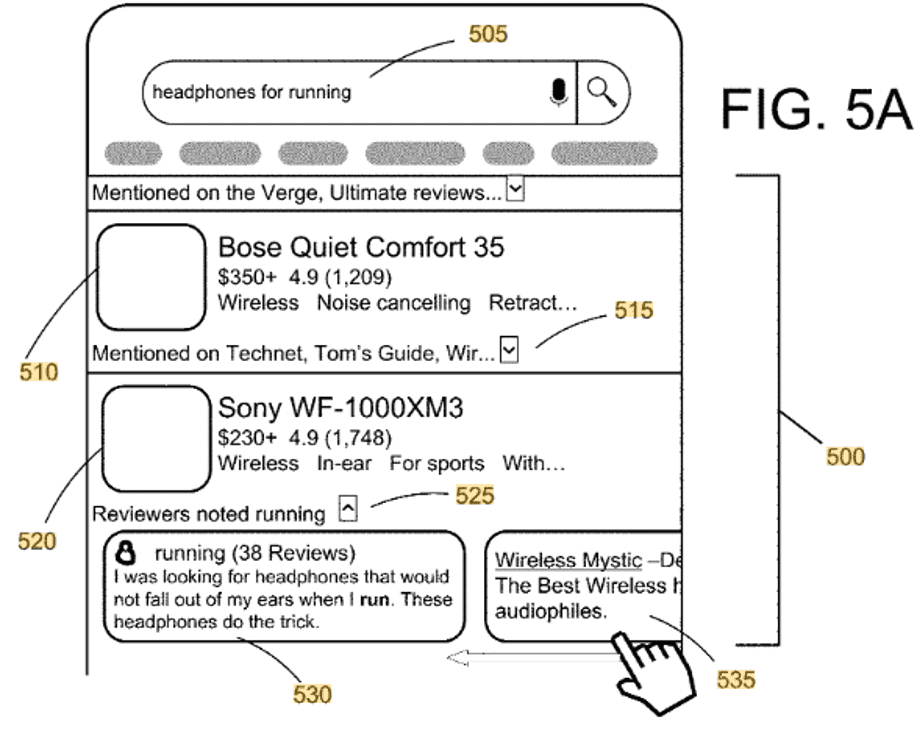
In this example, Google is able to extract information from reviews from users who specifically mention using headphones for running. The patent tells us that if they can extract information specific to running with headphones then this may actually result in higher rankings.
“In the example of FIG. 5A, the annotation includes a snippet of a user review that mentions running in conjunction with headphones. That users mention running in reviews for a product may result in a higher ranking for the particular product.”
They tell us that showing this in the SERPS could result in fewer follow-on queries from the searcher because the “user has a level of confidence that the result matches the intent.”
Again, encourage your customers to leave detailed reviews explaining how they use your products! It may also be helpful to give your reviewers specific details on what you’d like them to cover.
Knowing what details are important to a searcher who is interested in this product is important. One of Google’s recommendations for writing good product reviews is:
“Do your reviews Identify key decision-making factors for the product’s category and how the product performs in those areas? For example, a car review might determine that fuel economy, safety, and handling are key decision-making factors and rate performance in those areas.”
We think it may also be helpful to look at which annotations are appearing across many competitors for your search queries. We know that when Google uses structured data something that is important is corroborating information across several sources. The same may be true for unstructured data that is extracted from pages. For the Larceny bourbon example shared earlier, we found that many of the pages that had annotations included that there was a “reasonable price point”. We think it is a good idea to look at which annotations Google pulls from other pages, and if it makes sense, include this information on your pages as well. It likely is also helpful to look at user generated content on this topic on sites like Reddit and Quora to see whether there is a recurring theme in the attributes that are discussed for your product.
Query: iPhone 10 and Newest iPhone
In this example, the annotation given is to show that there is a newer version available. They call this a “version change annotation type”:

This reminds me of Google’s recommendation on product reviews which says, “Do your reviews describe how a product has evolved from previous models or releases to provide improvements, address issues, or otherwise help users in making a purchase decision?” Giving your searchers the most up to date information possible is likely important in Google’s eyes.
You may also trigger annotations for product searches if your product has been mentioned in authoritative “top 10” lists. This troubles me a little as I have heard reports of companies paying for placement in lists like this. Hopefully the most reputable of these lists are trustworthy and not unduly influenced by payment for placement.
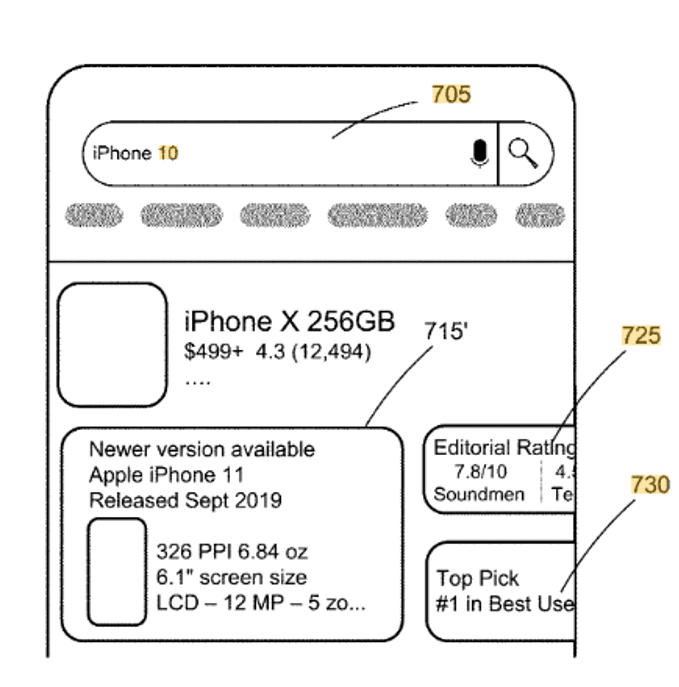
Some annotations may include video snippets which are called “media annotations” in the patent.
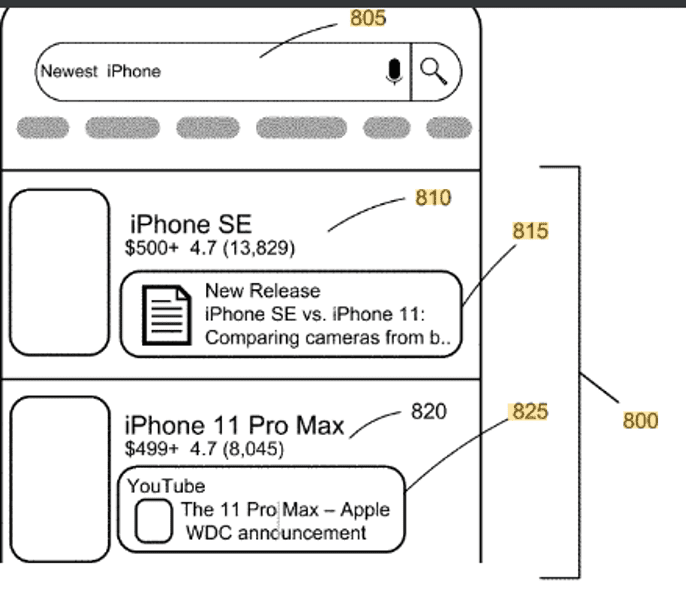
“A media annotation may refer to a video explaining, rating, or otherwise relating to the item. In some implementations a media annotation may be associated with curated sources, e.g., a company that sells an item or a news organization.”
Producing rich media content to discuss your products could be helpful for many reasons.
Query: Long skateboard
In this case, several product attributes such as dimensions are shown in the annotation:
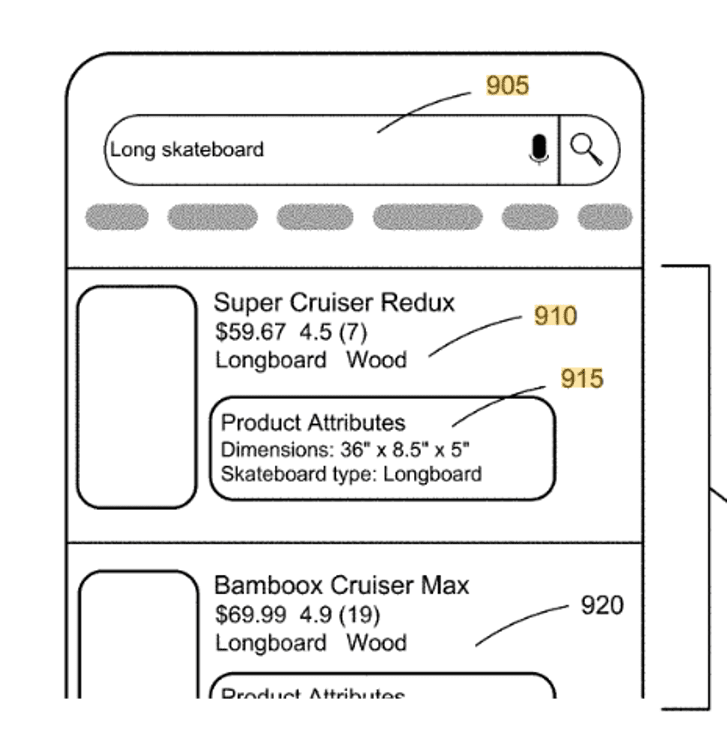
“A query context annotation type may use a query term related to measure and emphasize the product attributes that meet those terms.” Google is able to identify that a searcher who looks for “long” skateboards would find this annotation useful.
One of Google’s recommendations for writing good product reviews is to “provide quantitative measurements about how a product measures up in various categories of performance?”
This is where first-hand expertise on a product comes in handy. If you know your products well, you know what searchers are looking for. Rather than simply regurgitating what everyone else says about a product, you may be able to identify what other aspects are important to searchers. You might also be able to glean some information from GSC query data here. Look for queries where searchers are looking for information on specific aspects and attributes of your products and ensure that you’ve answered their questions in your copy or in user reviews on your page.
How can we use this information to improve our content?
Here is the diagram provided to explain how the system of generating annotations works.

If you have content that discusses products, we thoroughly recommend reviewing and taking seriously Google’s recommendations on writing good product reviews. These aren’t just wishful thinking from Google. We believe that all of these are things that they attempt to reward with their algorithms.
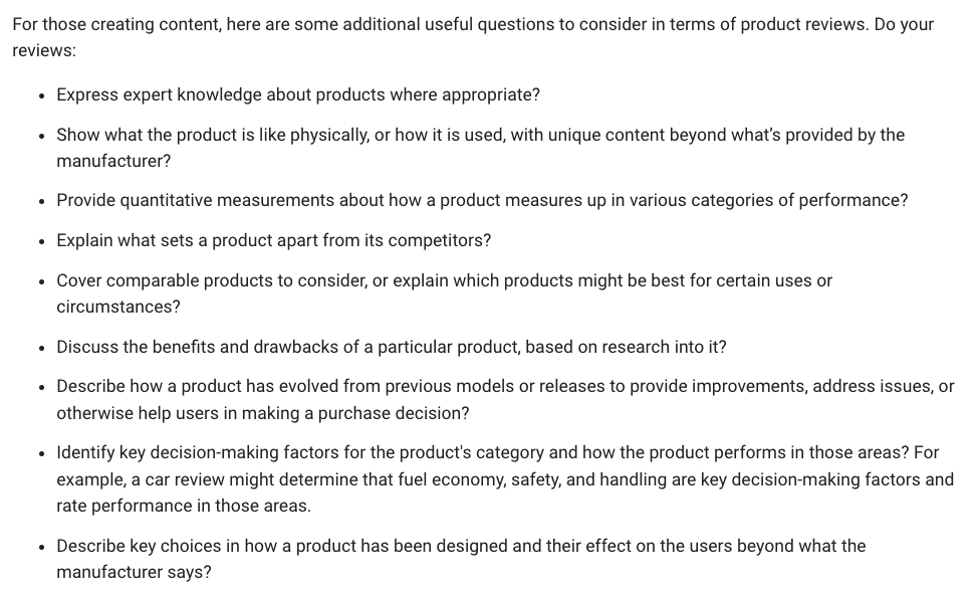
Based on reading this patent, the tips we will be recommending to our clients as we do page-level optimizations to help them create the best content possible include the following:
- Pages that produce these annotations may rank better because they do a good job at satisfying user intent.
- Write product reviews in easy to understand sentences. If Google is extracting unstructured data from pages, it is important that NLP (natural language processing) is able to parse your writing. We hope to learn more at MHC soon on using n-gram information to optimize content.
- Be sure to cover the pros and cons of a product when writing about it.
- Do all you can to encourage your customers to leave detailed, helpful reviews.
- Look at which annotations your competitor’s search results have and if it makes sense, add this information to your pages as well. Also, look at what real people are saying on Reddit or Quora in regards to your product to find the common attributes that are discussed for your topic.
- Mine GSC keyword data to determine what attributes your customers are searching for in association with your products and be sure to cover them in your content.
- If possible, try to get your products mentioned on authoritative sites, especially top ten lists.
- If writing about older models of products, be sure to direct the searcher to the newest model available.
- Produce video content about your products if possible.
I hope you have found this information useful! Google seems to really be emphasizing high quality product related content lately. We expect that when we see the full power of MUM which is able to extract entity information from videos and images, this will be even more important.
The MHC team has many years of experience in helping our clients optimize pages to perform better on Google search. This knowledge should make our page optimizations even better! If you are interested in having the MHC team review your content and make suggestions for improvement in the eyes of Google’s algorithms to potentially help you rank better, you can reach out here.



Comments are closed.